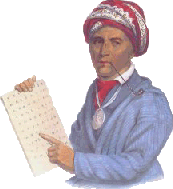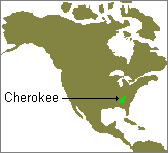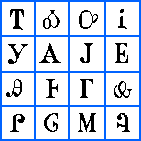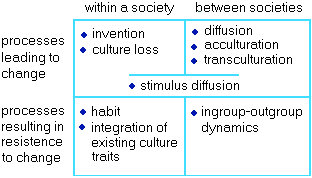All Cultures
are inherently predisposed to change and, at the same time, to resist change. There are dynamic processes operating that encourage the acceptance of new
ideas and things while there are others that encourage changeless stability. It is
likely that social and psychological chaos would result if there were not the conservative
forces resisting change.
There are three general sources of influence or pressure that are responsible for both change and resistance to it:
| 1. | forces at work within a society |
| 2. | contact between societies |
| 3. | changes in the natural environment |
Within a society, processes leading to change include invention and culture loss. Inventions may be either technological or ideological. The latter includes such things as the invention of algebra and calculus or the creation of a representative parliament as a replacement for rule by royal decree. Technological inventions include new tools, energy sources, and transportation methods as well as more frivolous and ephemeral things such as style of dress and bodily adornment.
Culture loss is an inevitable result of old cultural patterns being replaced by new ones. For instance, not many Americans today know how to care for a horse. A century ago, this was common knowledge, except in a few large urban centers. Since then, vehicles with internal combustion engines have replaced horses as our primary means of transportation and horse care knowledge lost its importance. As a result, children are rarely taught these skills. Instead, they are trained in the use of the new technologies of automobiles, televisions, stereos, cellular phones, computers, and iPods.
Within a society, processes that result in the resistance to change include habit and the integration of culture traits. Older people, in particular, are often reticent to replace their comfortable, long familiar cultural patterns. Habitual behavior provides emotional security in a threatening world of change. Religion also often provides strong moral justification and support for maintaining traditional ways. In the early 21st century, this is especially true of nations mostly guided by Islamic Law, such as Iran, Saudi Arabia, Afghanistan, and Pakistan.
|
|
|
21st century
professional |
The fact that cultural institutions are integrated and often interdependent is a major source of resistance to change. For instance, in the second half of the 20th century, rapidly changing roles of North American and European women were resisted by many men because it inevitably resulted in changes in their roles as well. Male and female roles do not exist independent of each other. This sort of integration of cultural traits inevitably slows down and modifies cultural changes. Needless to say, it is a source of frustration for both those who want to change and those who do not.
The processes leading to change that occur as a result of contact between societies are
Diffusion is the movement of things and ideas from one culture to another. When diffusion occurs, the form of a trait may move from one society to another but not its original cultural meaning. For instance, when McDonald's first brought their American style hamburgers to Moscow and Beijing, they were accepted as luxury foods for special occasions because they were relatively expensive and exotic. In America, of course, they have a very different meaning--they are ordinary every day fast food items.
Acculturation is what happens to an entire culture when alien traits diffuse in on a large scale and substantially replace traditional cultural patterns. After several centuries of relentless pressure from European Americans to adopt their ways, Native American cultures have been largely acculturated. As a result, the vast majority of American Indians now speak English instead of their ancestral language, wear European style clothes, go to school to learn about the world from a European perspective, and see themselves as being a part of the broader American society. As Native American societies continue to acculturate, most are experiencing a corresponding loss of their traditional cultures despite efforts of preservationists in their communities.
 |
|
|
Sequoyah |
While
acculturation is what happens to an entire culture when alien traits overwhelm it,
transculturation
is what happens to an individual when he or she moves to another society and adopts its
culture. Immigrants who successfully learn the language and accept as their own the
cultural patterns of their adopted country have transculturated. In
contrast, people who live as socially isolated expatriates in a foreign land
for years without desiring or expecting to become
assimilated
![]() participants in the host culture are not transculturating.
participants in the host culture are not transculturating.
There is one last process
leading to change that occurs as an invention within a society as a result of an idea that diffuses from another. This is
stimulus
diffusion
![]() --a genuine invention that is sparked by an idea from another culture.
An example of this occurred about 1821
when a Cherokee
--a genuine invention that is sparked by an idea from another culture.
An example of this occurred about 1821
when a Cherokee
![]() Indian named Sequoyah
Indian named Sequoyah
![]() saw English writing which
stimulated him to create a unique writing system for his own people. Part of his
syllable based system is illustrated below. Note that some letters are similar to English while
others are not. To see the entire Cherokee syllabary,
click here.
saw English writing which
stimulated him to create a unique writing system for his own people. Part of his
syllable based system is illustrated below. Note that some letters are similar to English while
others are not. To see the entire Cherokee syllabary,
click here.
 |
 |
|
16 of the 77 Cherokee |
It is also likely that ancient Egyptians around 3050 B.C. invented their hieroglyphic writing system after learning about the cuneiform writing system invented by Sumerians in what is today Southern Iraq.
There are processes
operating in the contact between cultures as well that result in resistance to change. These
are due to "us versus them" competitive feelings and perceptions. Ethnocentrism
![]() also leads people to reject alien
ideas and things as being unnatural and even immoral. These ingroup-outgroup dynamics commonly
result in resistance to acculturation and assimilation.
also leads people to reject alien
ideas and things as being unnatural and even immoral. These ingroup-outgroup dynamics commonly
result in resistance to acculturation and assimilation.
Summation
In order to better grasp the relationship between all of the different mechanisms of change operating within and between societies, it is useful to see them again in summary:

